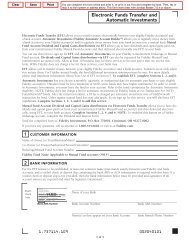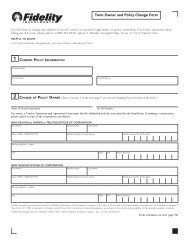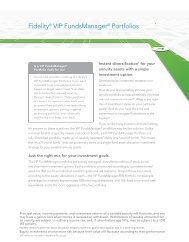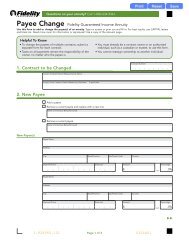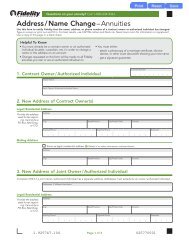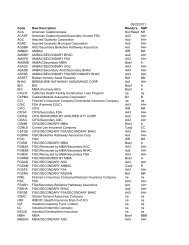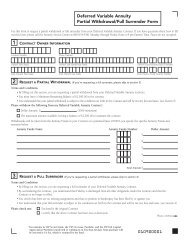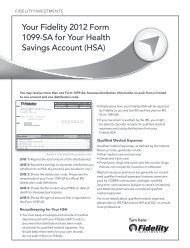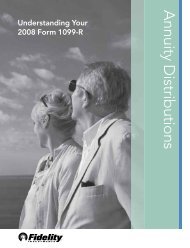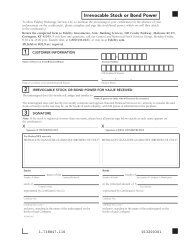Program Fundamentals: Fidelity® Strategic Disciplines
Program Fundamentals: Fidelity® Strategic Disciplines
Program Fundamentals: Fidelity® Strategic Disciplines
Create successful ePaper yourself
Turn your PDF publications into a flip-book with our unique Google optimized e-Paper software.
grade; bonds with lower ratings are considered higher risk, speculative, or high yield. Lower-rated<br />
bonds will often have higher yields to compensate investors for increased risk. You need to consider<br />
your risk tolerance when evaluating potential bond investments. Municipal bond issuers may pay a<br />
premium to an insurer, who will provide interest and principal payments on the bond in the event of<br />
the failure of the issuer to do so. The credit rating of these insured bonds can be higher than that<br />
of the issuer. In the case of insured municipal bonds, evaluating the rating of the insurer as well as<br />
the issuer is recommended for a more complete assessment of the bonds’ credit risk profile. The<br />
rating of the issuer is sometimes referred to as the underlying rating. Should something change<br />
that causes a rating agency to change its rating for a particular bond or issuer, the market price<br />
of the bond and the resultant yield on the municipal bond is likely to change as a result. Investors<br />
are encouraged to learn more about the rating definitions and methodologies used by the various<br />
rating services. These definitions and methodologies are available at www.standardandpoors.com<br />
and www.moodys.com.<br />
Interest Rate Changes. Bonds have varying levels of sensitivity to changes in interest rates. In<br />
general, the price of a bond can fall when interest rates rise and can rise when interest rates fall.<br />
Bonds with longer maturities can be more sensitive to interest rate changes. In other words, the<br />
longer the maturity of a bond, the greater the impact a change in interest rates could have on the<br />
bond’s price. In addition, short- and long-term interest rates do not necessarily move in the same<br />
amount or the same direction. Short-term bonds tend to react to changes in short-term interest rates,<br />
and long-term bonds tend to react to changes in long-term interest rates.<br />
Taxes. Interest income generated by municipal bonds is generally expected to be exempt from<br />
federal income taxes and, if the municipal bonds are held by an investor with legal residence in<br />
the state of issuance, state and local income taxes. Such interest income may be subject to federal<br />
and/or state alternative minimum taxes. Investing in municipal bonds for the purpose of generating<br />
tax-exempt income may not be appropriate for investors in all tax brackets. Generally, tax-exempt<br />
municipal bonds are not appropriate holdings for tax-advantaged accounts, such as IRAs and<br />
401(k)s. Short- and long-term capital gains and gains characterized as market discount recognized<br />
when municipal bonds are sold or mature are generally taxable at both the state and federal level.<br />
Short- and long-term losses recognized when municipal bonds are sold or mature may generally<br />
offset capital gains and/or small amounts of ordinary income at both the state and federal level. Tax<br />
code changes could impact the municipal bond market. Tax laws are subject to change, and the<br />
preferential tax treatment of municipal bond interest income may be removed or phased out for<br />
investors at certain income levels.<br />
Call Provisions. Bonds may have a call feature that allows or requires the issuer to redeem the<br />
bonds at a specified price and date before maturity. Because a call provision offers protection to the<br />
issuer, callable bonds usually offer a higher yield than comparable noncallable bonds, to compensate<br />
the investor for the risk that the investor might have to reinvest the proceeds of a called bond at a<br />
lower interest rate. Bonds are often called when interest rates have declined from the time the bond<br />
was issued. For bonds with a call feature, investors should be aware of the yield to call as well as<br />
the yield to maturity. For callable bonds, a call may result in a lower-than-expected yield or even a<br />
loss. Investors may also face reinvestment risk, which is discussed later in this document. Investors<br />
should also be aware of extraordinary redemption provisions. These provisions give a bond issuer<br />
the right to call the bonds due to a one-time occurrence, as specified in the offering statement. The<br />
circumstances could range from natural disasters, interruption to revenue sources, unexpended bond<br />
proceeds, or cancelled projects to almost anything else.<br />
Reinvestment Risk. In a declining interest rate environment, bondholders risk having to reinvest<br />
their interest income and any return of principal, whether scheduled or unscheduled, at lower<br />
prevailing rates.<br />
14



